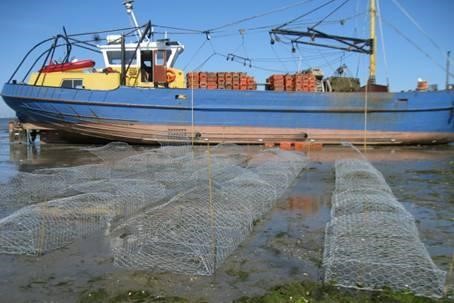Oyster Reefs
Oysters are a bivalve shellfish that are often referred to as “ecosystem engineers” because of their tendency to attach to hard substrate or other oyster shells to create large reefs made up of thousands of individual oysters. These reefs play an essential role in the nearshore coastal and estuarine environment, providing habitat for many other species including recreational and commercial fish, creating nursery habitat for fish and crabs and providing small animals shelter from larger predators.
In addition to offering shelter and food to numerous coastal species, oyster reefs provide a number of benefits that promote healthy coastal environments. Oyster reefs buffer coasts from waves, reducing erosion and creating calmer waters that support the growth of coastal marshes and seagrass beds. Oysters are also extremely effective filter feeders, improving their surrounding water quality and clarity and further enhancing the health of the larger bay or estuarine systems in which they reside.
Oyster reefs can be found in lower energy environments along the Atlantic coast, Gulf of Mexico, and Pacific coast. In southern latitudes reefs may grow large enough to be intertidal, with the tops of reefs breaking the surface of the water at lower tides, whereas ice scour and other limitations in northern latitudes restrict oyster reefs to being entirely subtidal.
Hazard Mitigation
Oyster reefs serve as natural breakwaters – their physical structure absorbs the force of waves, creating calmer waters on the shoreline side of the reef and reducing the impacts of erosion. Studies from the Gulf of Mexico have found that oyster reefs are capable of reducing the energy of high power waves by as much as 76 to 93 percent. The effectiveness of any single reef will depend on its size, orientation, and location. In northern latitudes, where reefs are entirely subtidal, their ability to reduce wave energy may be reduced.
In addition to directly reducing wave energy, oyster reefs play an important role in protecting and building coastal marshes and seagrass beds, which can in turn provide their own flood and erosion reduction benefits. Natural coastal protection is most effective when multiple habitat types are able to work in concert together to maximize the overall benefits to coastal communities.

Threats
As much as 85% of all oyster reefs globally have been lost in the last two centuries, making oyster reefs among the most threatened habitats in the world. A combination of overfishing, habitat destruction, and water quality degradation have conspired to significantly impact oyster reefs in the United States. While the status of oyster reefs globally is dire, concerted efforts to address water quality and recreate habitat – largely by recycling used oyster shells to create new substrate for juvenile oysters to attach to – have shown some promise of starting to restore wild oyster populations.
Co-Benefits
Oysters provide a wide array of benefits beyond the hazard mitigation role they play. While the wild harvest of oysters has been greatly reduced because of the overall loss of wild oyster reefs, the oyster fishery is still one of the most valuable in the US. In the Chesapeake Bay alone, the dockside value of oyster catch was approximately $44 M in 2013-2014. Dockside value, however, only accounts for a small portion of the overall value of the fishery, as one analysis found that each $1 M of dockside value in the Chesapeake Bay equated to $36 M in total sales and almost 1000 jobs.
In addition to the direct harvest value of oysters, oyster reefs provide essential habitat for a number of commercial and recreational fishery species. Species ranging from blue crab to flounder to herring, and many, many more, have been observed relying on oyster reefs at some stage of their life cycle.
The water filtering capacity of oysters is another tremendous benefit. An individual oyster can filter plankton, nitrogen, and other pollutants from as much as 50 gallons of water per day, providing an enormous benefit to coastal waters that are increasingly impacted by runoff and pollution. Before suffering massive declines, its estimated that historically the oysters in the Chesapeake Bay could filter the entire volume of the bay once a week.
Additional Resources
“Shellfish Reefs at Risk” is a report focused on the current global status of oyster reefs, the ongoing threats to oyster reef health, and a suite of suggestions for how to improve and restore the global status of reefs.
NOAA has put together a nice primer on the value of oyster reefs from an ecological and economic vantage point.

